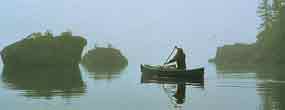
![]() Story as a Google Doc
Story as a Google Doc
By ADAM DeLAY
Capital News Service
LANSING – Wildlife enthusiast Jim DuFresne describes the scene as breathtaking.
“You take a six-hour boat ride where all you see is the clear water,” he says. “Then when you finally get there, you really feel like you’re in the wilderness and surrounded by nature. It’s truly an incredible feeling.”
The Clarkston outdoors writer isn’t talking about a far-away Alaskan forest or the famed Yellowstone National Park. He’s talking about Michigan’s Isle Royale National Park.
Established as the first island national park in 1940, Isle Royale is about 50 miles off the coast of the Keweenaw Peninsula in Lake Superior. There are no paved roads or motor vehicles on the island, except emergency and service vehicles, and access is limited to boat or floatplane.
DuFresne, author of “Isle Royale Park: Foot Trails & Water Routes,” (Mountaineers Books, 14.95) and a frequent contributor to the outdoor site Michigantrailmaps.com, said the island is a great asset to the state.
“It’s a beautiful place and one of a kind in Michigan.”
Despite its beauty, the National Park Service lists Isle Royale as one of the least-visited national parks, attracting only 17,000 to 18,000 visitors annually. Yellowstone sees that many in a day.
Isle Royale supervisory ranger Greg Blust said that even with comparatively few visitors, it’s still used heavily for backpacking and canoeing.
“People tend to focus on us being one of the least-visited parks but we actually have the most backcountry use per acre of any park in the country, including the Smokies,” he said. “It’s a backpacker’s and kayaker’s paradise.”
Blust also said the number of visitors is limited because Isle Royale is one of the few parks to close during the winter due to harsh weather.
Despite low attendance, Dallas Bond, executive director of the Keweenaw Peninsula Chamber of Commerce in Houghton, said the national park is an economic engine for the region.
“People will come up the day before they leave for the island and will stay in a motel, eat dinner and shop here, which creates economic activity,” he said. “I would say about half of our region’s economy is based on the tourism industry.”
DuFresne said more could be done to promote Isle Royale and nearby areas.
“They need to use Isle Royale as a crown jewel,” he said. “Even if you don’t hike, you could stay at the lodge. You could also take advantage of the waterfalls, canyons and other parts of the area.”
Bond said he’d like to do more to promote the Keweenaw Peninsula but that resources are limited.
“Many of the businesses we have are small and locally owned, so there’s not a lot of money to do things like advertise or buy new ferries to travel to the island,” he said.
Bond also said he’s disappointed that the Pure Michigan campaign hasn’t focused on the area. Pure Michigan is the state’s advertising campaign that promotes tourism through television and radio ads.
“The ads are great and very enticing but unfortunately generally focus below the Mackinac Bridge,” he said.
Kirsten Borgstrom, media relations manager for Travel Michigan, said the campaign doesn’t focus on certain areas over others. Travel Michigan is the official state tourism marketing arm.
“Different organizations will come to us with money and we will match funds to put together ads for them,” she said.
Borgstrom also said that while some localities can’t afford to participate in the ads, Pure Michigan offers other ways of to help them.
“One thing we did in Keweenaw is contact travel writers who are interested in backpacking and kayaking and provide them with information for a potential article,” she said.
A potential problem with increasing park attendance is that many people enjoy its seclusion, so a flood of visitors could make the island less attractive.
DuFresne said he’s seen overcrowding problems at other parks.
“There are times at Great Smoky Mountains National Park where you feel overwhelmed by the crowd,” he said. “At Isle Royale, I did a three-day hike by myself and didn’t see another person. Where else can I do that?”
Bond said that since the park is also a biosphere reserve, more guests could be environmentally harmful.
“We would love to see more visitors but we don’t want to see the ecosystem damaged,” he said. “We would like to see a good balance of visitors on the island.”
But DuFresne said it’s possible to boost visitors without hurting the environment or the wilderness experience.
“One idea is to increase the amount of lodging on different parts of the island, which would attract non-backpackers and spread the population out,” he said. “Also, most people visit in July. If we could encourage people to visit the island at other parts of the season, it wouldn’t seem crowded.”
Isle Royale will open for the 2010 season on April 16.
© 2009, Capital News Service, Michigan State University School of Journalism. Not to be reproduced without permission.
Spartan Newsroom - News and information from student journalists at the Michigan State University School of Journalism
Spartan Newsroom (https://news.jrn.msu.edu/2009/12/unspoiled-isle-royale-offers-incredible-feeling/)